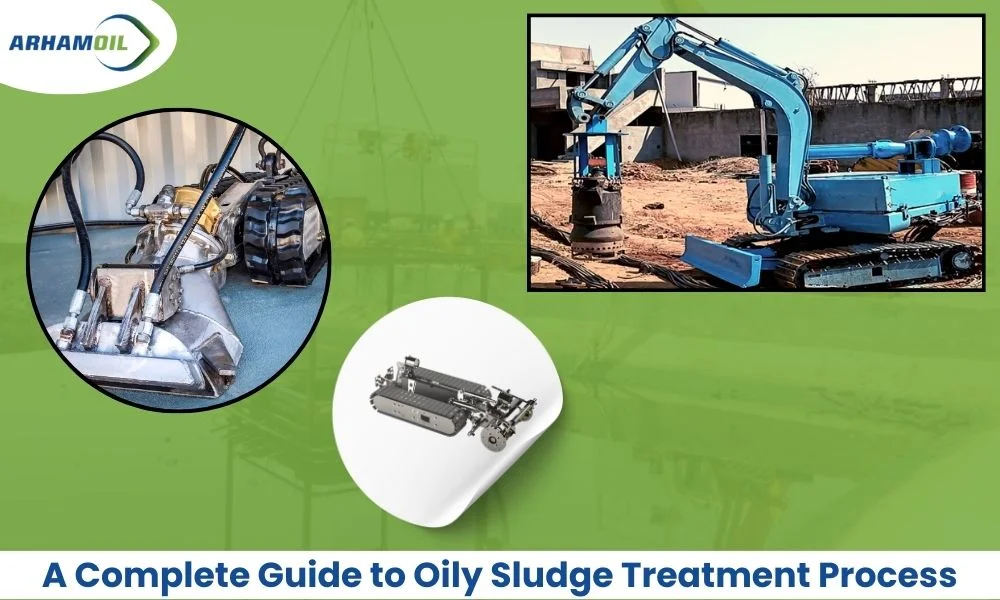Hydrocarbon Waste Processing: Protecting the Environment Through Innovation
September 11, 2024Bioremediation vs New Age Solutions: A Battle for Sustainable alternative
September 18, 2024Oily sludge is a significant by-product in many industrial fields, particularly the oil and gas industry. It consists of sediments or solid particles suspended in a mixture of water and oil. Without proper treatment, this mixture can lead to environmental hazards and economic losses. As regulatory frameworks tighten and industries aim for sustainability, efficient oily sludge treatment processes are essential. We specializes in advanced technologies to manage and process oily sludge effectively, ensuring environmental safety. This article outlines the major steps in the oily sludge treatment process, highlighting how they support slop oil recovery, oil sludge processing, and oil recovery.
What is Oily Sludge?
Before beginning the oily sludge treatment process, it’s crucial to understand what oily sludge is. Typically, oily sludge originates from refining operations, cleaning storage tanks, and oil-water separators. It consists of hydrocarbons, water, and solid wastes. If left untreated, oily sludge can lead to environmental hazards, such as soil and water contamination.
Why the Oily Sludge Treatment Process is Necessary
The oily sludge treatment process is vital not just for adhering to environmental regulations, but also for recovering valuable resources from the sludge. Through this process, slop oil can be recovered, reprocessed, and reused, reducing costs and mitigating environmental impact. Furthermore, oil sludge recovery helps minimize waste, contributing to more sustainable practices.
Oily Sludge Treatment Process: Step-by-Step
1. Sludge Collection and Transportation
The first step in the oily sludge treatment process involves collecting sludge from storage tanks, lagoons, or separators. We use specialized robotic systems that enable non-man entry sludge removal. This approach enhances safety and ensures efficient collection. Our advanced systems can handle large volumes of sludge, making the process more cost-effective.
2. Sludge Separation: Oil, Water, and Solids
Once the sludge is collected, the next step is separating its components—oil, water, and solids. This is a critical part of oil sludge processing. We use advanced centrifugation and filtration technologies to efficiently separate the sludge into:
- Oil Recovery: Essential for slop oil recovery, this step recovers hydrocarbons that can be reused. The recovered oil is often refined further for use in other industrial applications, closing the loop on oil use.
- Water Recovery: The water extracted during the process can either be treated for reuse or discharged safely, minimizing waste.
- Solid Waste: Solid sediments are processed further to reduce their environmental impact or prepared for safe disposal.
3. Thermal and Chemical Treatment
After separation, thermal and chemical treatments are applied to the sludge. Thermal treatment involves heating the sludge to extract residual oil from the solid waste, which improves oil recovery rates. Chemical additives help break down emulsions, making it easier to separate oil from water. This step enhances the efficiency of both oil sludge processing and oil sludge recovery.
4. Oil Sludge Processing: Improving Efficiency
The next stage focuses on maximizing the quantity and quality of the recovered oil. This is where oil sludge processing plays a crucial role, particularly for slop oil recovery. Several methods can be used, depending on the sludge’s composition, including:
- Mechanical Treatment: High-pressure systems separate oil, water, and solids more effectively, boosting the efficiency of the treatment process.
- Bioremediation: For an eco-friendly solution, biological agents such as bacteria are introduced to break down hydrocarbons. This method is especially useful for large-scale Oily Sludge Treatment in oil refineries.
- Solvent Extraction: In cases where the sludge contains a high percentage of oil, solvent-based systems are used to recover as much oil as possible.
5. Final Disposal and Waste Management
Once the valuable oil has been recovered, the remaining waste must be managed responsibly. Treated solid waste is typically dewatered to reduce its volume and is then disposed of according to environmental regulations. In some cases, the treated solids can be used for land reclamation or other industrial applications, promoting sustainable waste management.
Benefits of the Oily Sludge Treatment Process
The oily sludge treatment process offers numerous benefits, including resource conservation, environmental compliance, and cost savings.
- Resource Recovery: One of the most significant advantages is the recovery of valuable hydrocarbons through slop oil recovery. By reusing these resources, companies can reduce their dependence on new materials, leading to lower production costs.
- Environmental Compliance: Proper oily sludge treatment ensures that companies meet strict environmental regulations, avoiding fines and reducing soil and water contamination.
- Cost Savings: Effective oil sludge processing reduces the volume of waste, which in turn lowers transportation and disposal costs.
- Improved Safety: We prioritize worker safety by using robotic, non-man entry systems for sludge removal and treatment. This minimizes the risk of accidents, as workers are not required to enter hazardous environments.
Arham Oil’s Expertise in Oily Sludge Recovery
We are one of the major companies in oil sludge recovery and treatment, offering better solutions focused on safety, efficiency, and sustainability. Our oily sludge treatment process is designed to recover the maximum amount of oil while minimizing waste. From slop oil recovery to oil sludge processing, our services are tailored to meet each client’s specific needs. We utilize state-of-the-art equipment, including robotic cleaning systems, to ensure optimal performance and safety.
Conclusion
The oily sludge treatment process is essential for modern oil and gas operations. Proper treatment not only enables companies to recover valuable resources but also helps them comply with environmental regulations and reduce operational costs. At Arham Oil, we offer customized solutions for all aspects of sludge treatment and oil recovery. Whether it’s slop oil recovery, oil sludge processing, or oil sludge recovery, our expertise ensures that your needs are met in the most efficient and eco-friendly way possible.
For more information about our services, reach out to us, where we strive to provide the best in sludge treatment and resource recovery.


